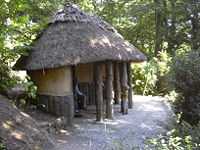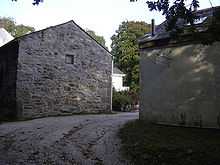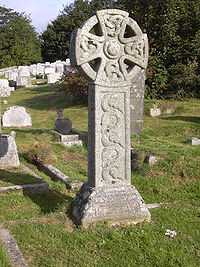Alice Hext
Alice Hext (2 March 1865[1] - 14 September 1939[2]) was a Cornish philanthropist, garden developer and magistrate. She was the owner of the Trebah Estate and leisure garden, near Falmouth in Cornwall from 1907 to her death in 1939,[3] and generously supported the development of sports and social activities in the Parishes of Constantine and Mawnan.[4]
Birth & Marriage
Alice Petherick was born in St. Austell, on 2 March 1865, the daughter of George Petherick, a Bank Manager[1][2] and his wife, Emily (born Barratt).[5]
She married Charles Hawkins Hext, a banker, on 16 April 1891 in Kensington.[6] Both her father and her husband bore names "well-known among West Country gentry".[7]
Charles and Alice Hext are shown in the 1901 census as resident at Polgwin in the civil parish of Bodmin, Cornwall. Charles is described as "Retired Banker" aged 49. Alice is shown as age 36.[8] In 1907, they moved to Trebah. Charles Hext served as Mayor of Bodmin in 1895[9] and as High Sheriff of Cornwall in 1915.[10] He died on 3 January 1917.[2]
Trebah Garden

She developed Trebah Garden,[11] the beautiful garden created by the Fox family of Falmouth, on the northern side of the Helford River at Trebahwortha, near Mawnan Smith.
“Mrs. Hext was a keen horticulturist and a frequent exhibitor at county and local garden shows and in her support of these she did much to help allotment holders and small gardeners. Her grounds were always open to the public and were often used for fetes and garden parties.” [4]
After her death, the estate was split up and the garden passed between several owners and decayed. The "lost garden" at Trebah was rescued by the Hibbert family, who established a charitable trust to enable the garden to be open to the public again. A cob and thatch arbour in the garden was restored and given the name "Alice's Seat".[12]
Philanthropy
She was a noted benefactor, to the County and in the Parishes of Constantine and Mawnan. In particular, she gave the playing field and sports pavilion to the village of Constantine in 1921, in memory of her husband, Charles Hawkins Hext.[13] There is a commemorative plaque at Constantine Social Club, recalling her generosity to the village.
Protective Covenant

In 1928, she acquired Goongillings Farm[14] and rebuilt the old quay as a decorative feature.[15] She created a public right of way, from the village of Constantine to the river, through her land and covenanted its future use against inappropriate development.[16]
Public service
She served as Justice of the Peace from June 1921 until 1939.[17][18]
Her obituary in the West Briton says:
“A Justice of the Peace for the East Kerrier District, Mrs. Hext regularly attended the monthly meetings of the court at Penryn and she took a particular interest in the welfare of young people unfortunate enough to come before the magistrates.In the Constantine-Mawnan area she was interested in and almost invariably a helper in, anything for the betterment of village life. She gave to Constantine its present recreation ground and pavilion, and in both villages she supported sporting and social organisations, almost without exception.” [4]
One of her greatest interests was the Girls' Friendly Society.[19] She was president of the county the branch, and she was constantly active in furthering the good causes of that organisation in Cornwall and beyond it.
Some years ago, she presented a fine house, Miramar, at Grove-place, Falmouth, as a G.F.S. lodge for the Truro Diocese, enabling girls to be trained there for domestic service and affording hundreds of young women from other parts of the country and from abroad to enjoy holidays under the auspices of the movement at Falmouth.
A keen advocate of every possible facility for children in both elementary and secondary schools, Mrs. Hext was a valued education worker in the county and in the Falmouth area, being associated with both the Mawnan and Constantine elementary schools, a governor of Falmouth County High School for Girls, and a frequent benefactor to the Falmouth Grammar School. When village or secondary schools were in need of some improvements, Mrs. Hext not infrequently made herself responsible for them, and she often provided prizes as an inducement to scholars in some particularly commendable direction.
Death and legacy

She died on 14 September 1939, and was buried in the churchyard of Saint Constantine's church.[20]
"Among the wreaths were tributes from the presidents, vice-presidents and members of the Truro Diocesan Council of the G.F.S.; Constantine Parochial Church Council, Constantine Nursing Association, Constantine Recreation Committee, Constantine Garden Society, the teachers and pupils of Ponjeravah Day Schools, Constantine Branch of the G.F.S.; the indoor staff; the outdoor staff; and “the garden she loved”.[4]
Also present were a number of her nieces and nephews, including the MP for Penryn and Falmouth, Maurice Petherick.
The Girls Friendly Society no longer functions in Falmouth but is a global organisation. The Constantine Sports and Social Club, that she endowed, still functions and the land she protected from development by covenant is still green. The garden that she and Charles Hext developed gives much pleasure to many people.
Notes and references
- ↑ 1.0 1.1 Birth Register: Entry No.401. Place of birth and residence of father: High Cross, St. Austell
- ↑ 2.0 2.1 2.2 Burke's Landed Gentry (1952) page 1220: Hext family
- ↑ Mawnan History Group (2002). The Book of Mawnan: celebrating a South Cornwall parish. Tiverton, Devon: Halsgrove. ISBN 1-84114-148-8.
- ↑ 4.0 4.1 4.2 4.3 Obituary in The West Briton: 21 September 1939 Page 6, Column e. "LOSS TO CORNWALL/ DEATH AT TREBAH OF MRS. CHARLES HEXT/ DEVOTED PUBLIC WORKER"
- ↑ Burke's Landed Gentry (1952) page 2016: Petherick Family
- ↑ He was born 22 December 1851, the third son of Thomas Hext, JP. of Trenannen (1805-1881) and Rhoda Charlton Yeatman, his wife ( -1914). The family were six brothers and five sisters. Source: Burke's Landed gentry, 1952.
- ↑ Henderson, Charles (1937). A history of the parish of Constantine in Cornwall. G.H. Doble (edited text after Henderson's death). Truro: Royal Institution of Cornwall. pp. 208–209.
- ↑ The 1901 census includes a coachman, a cook and two maids at Polgwin. All are shown as born in Cornwall (RG13/2201, pages 4 and 5).
- ↑ Ernest Gaskell (No date but between 1906 and 1912) Cornwall's leaders: Social and Political, London, EC: Queenhithe Printing & Publishing. Charles Hext was a JP on the Bodmin bench and "politically conservative and imperialist". His wife, Alice Hext, is described as the second daughter of George Petherick, of Porthpean Hill, St. Austell and of 2, Bramham Gardens, South Kensington. His hobbies were "sailing and gardening".
- ↑ Cornwall Record Office: Document ref. no. D/R/157 Photograph of Sheriff's Coach with driver, footmen and policeman at Bodmin assizes. Caption: Charles Hawkins Hext, sheriff Date: 1915.
- ↑ Tony Russell Trebah: guide to the garden of dreams, Spalding : Woodland and Garden, 2005. ISBN 0-9521952-3-2
"Two years later Edmund Backhouse died and in the following year, Trebah was sold to Charles Hawkins Hext and his wife Alice. Their stewardship, which lasted until the outbreak of the Second World War, was truly a golden era in Trebah's history and the time when the garden reached its peak... Ponds in the middle of the garden were constructed and stocked with rainbow trout and golden orfe ... Then in 1924, on a marshy area at the bottom of the valley, the subsoil was puddled to create what has subsequently been known as Mallard Pond... Most of these new innovations were carried out by Alice Hext, Charles having died in 1917."
- ↑ Caroe & Partners, Architects - Case study: Trebah Gardens. Information on the creation of "Alice's Seat" is on page 2 http://www.caroe.co.uk/uploads/download/trebah.pdf.
- ↑ Trethowan, Gerald; Liz Moore (2001). The Book of Constantine. Tiverton, Devon: Halsgrove. ISBN 1-84114-102-X., p. 131
- ↑ School places to visits website: Goongillings Farm.
- ↑ Trethowan, p. 62
- ↑ Covenanted under Clause 8 of the National Trust Act 1937 The covenant of 14 December 1938 reads:
"The Covenantor is the estate owner in respect of fee simple free from incumbrances of the land at Trebah situate in the Parish of Constantine and lands in the parishes of Veryan and Gorran all in the County of Cornwall particulars of which are set out in the First Schedule hereto which land is delineated on the two plans hereto annexed and is thereon shown by the colour pink such particulars being taken from the Ordnance Survey Map for the County of Cornwall 2nd Edition on the scale 208.33 feet to 1 inch and is hereinafter referred to as “restricted land”."
- ↑ Cornwall Record Office: Quarter Sessions Record Book 1920-1923, page 285, entry for 28 June 1921. Alice Hext and three other women sworn in as Justices
- ↑ Kelly's Directory of Cornwall 1939.
- ↑ Girls' Friendly Society website.
- ↑ Gazette and News 20 September 1939: "Well-known Cornish lady: death of Mrs C. H. Hext". The obituary describes the funeral and notes that the Bishop of Truro conducted the service, as well as several of her nephews, including Maurice Petherick, Conservative MP for Penryn & Falmouth (1931-1945).